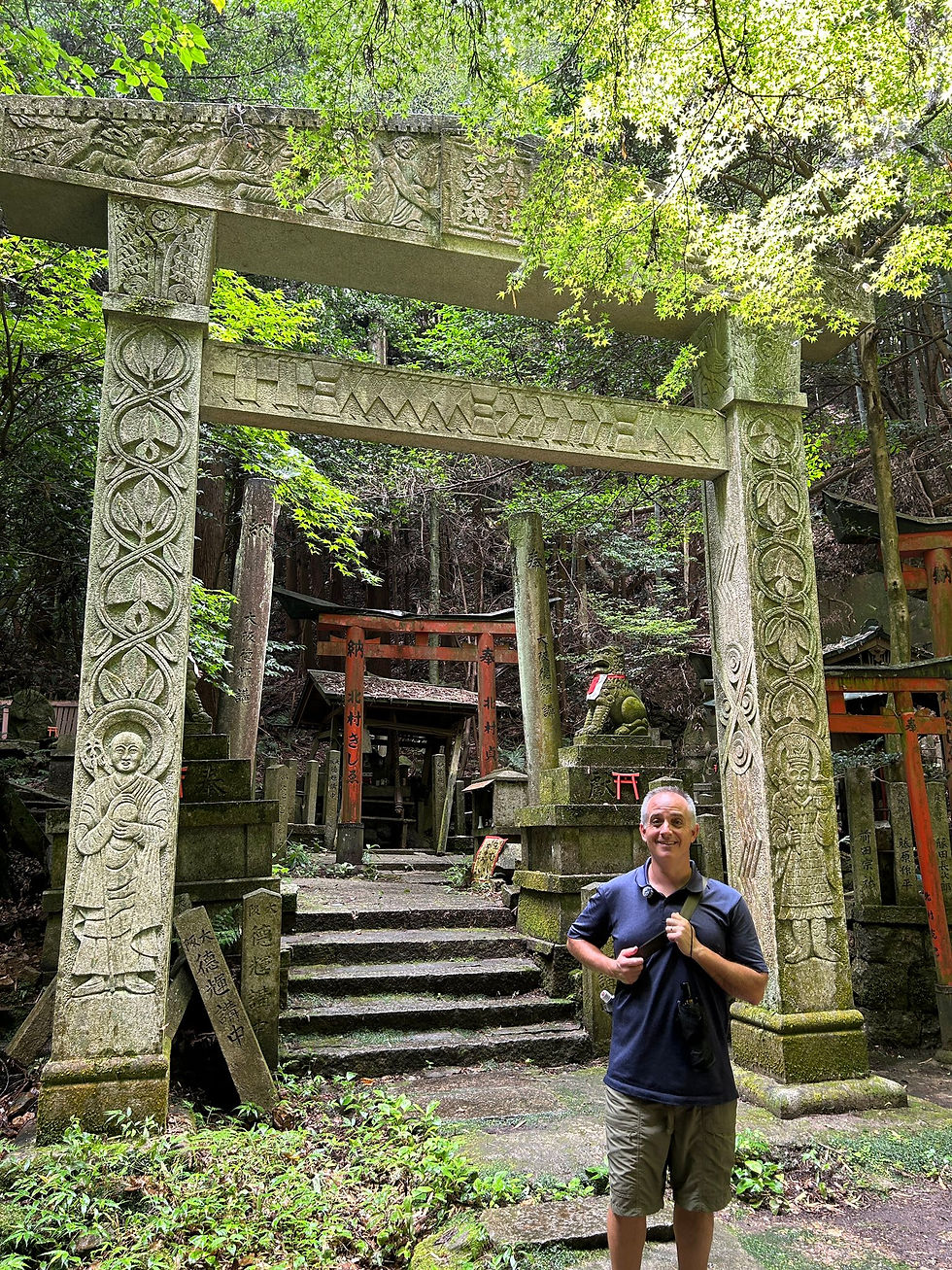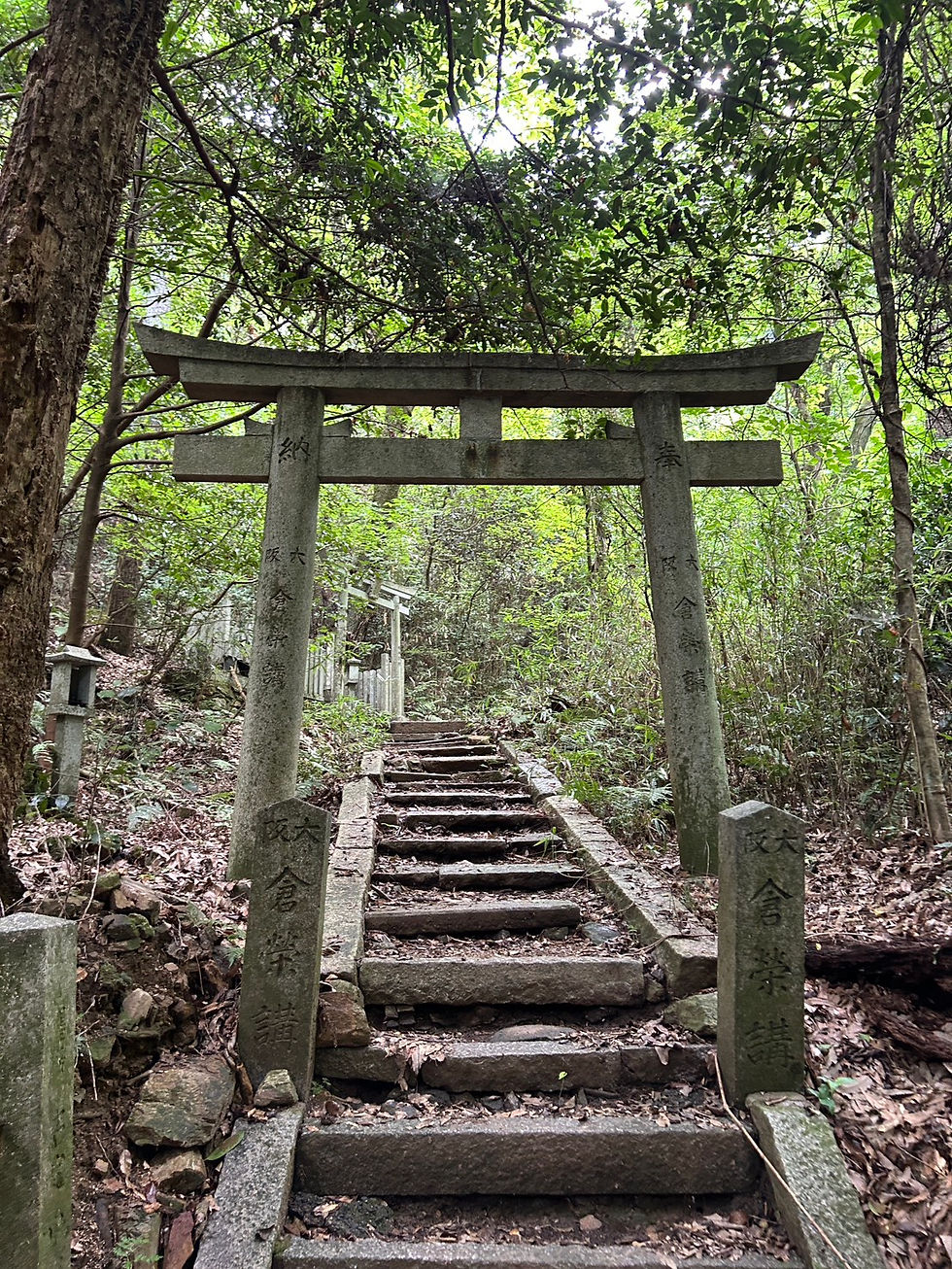From Oiwa Shrine to Kappa Country (HIDDEN PATHS meets Supernatural Japan Podcast- Part 1)
- Phillip Jackson

- Jul 19
- 4 min read
'HIDDEN PATHS - Walking Historical Kyoto' recently joined up with 'SUPERNATURAL JAPAN PODCAST' to take a walk around some of the interesting, scenic, and sometimes said to be haunted locations around Fushimi, Kyoto (links to Supernatural Japan Podcast below). The plan was to meet at Chushojima Keihan Station (the old stomping ground of the famous rebel Sakamoto Ryoma), take a local train to Fujinomori and then work our way back on foot to where we started at Chushojima. The first main target was Mount Oiwa and the abandoned Oiwa Shrine, but there were also a couple of interesting and historical sites to take a look at before we reached that point.


The Imperial Army Kyoto Headquarters - Upon leaving the east exit of Keihan Fujinomori we come to a stretch of the canal that links Fushimi to central Kyoto, along which goods would have been transported by Jikkobune boats to wharehouses in the Kiyamachi area (carrying such goods as sake, rice, timber, fuel wood, and other merchandise). This mode of transport was in use up until the early 1920's. Over the bridge and walking east alongside and under the Meishin Expressway elevated road we come to the grounds and (sadly out of site from this point) the old building of the Imperial Army Kyoto Headquarters. This headquarters building was constructed in 1908, and one of the former division commanders was Kanji Ishihara, who is said to have been one of the masterminds of the Manchurian Incident (The Manchurian Incident, also known as the Mukden Incident, was a staged false flag event on September 18, 1931, where a section of the South Manchurian Railway was bombed by Japanese soldiers, who then blamed Chinese nationalists). Today on these grounds in Kyoto is a girls school and a university campus.
The Tomb of Emperor Ninmyo - Walking further east we soon came to our next stop, the resting place of the Emperor of Fukakusa, Emperor Ninmyo. When Emperor Junna left the throne in 833, Ninmyo stepped up and Prince Tsunesada become Crown Prince. Political power struggles would then ensue! One of Ninmyo's wives, Junshi, was a younger sister of the influencial Fujiwara no Yoshifusa. Junshi gave birth to a son, Prince Michiyasu, and it was Yoshifusa's desire that Michiyasu replace Tsunesada as Crown Prince. In time, two of Tsunesada's aides believed an attack to depose him was imminent, and so they planned to take Tsunesada off to the eastern provinces to a safe hideaway. This plan got back to Ninmyo, he exiled the aides, and Tsunesada was thrown out of the imperial family to take responsibility for the conspiracy. Michiyasu became Crown Prince, and eventually Emperor Montoku. Later, a consort of Emperor Montoku, who also happened to be the daughter of Fujiwara no Yoshifusa had a child by Montoku. When that child became Emperor Seiwa in 858 he required a regent as he was too young, and the chosen regent to the new Emperor was none other than Fujiwara no Yoshifusa. His plan for power had finally come to fruition! (Pictured below, the Tomb of Ninmyo)

Moving on from the Tomb of Emperor Ninmyo we followed markers on the route of the Kyoto Trail, and before long we found ourselves at the foot of Mount Oiwa, and the entrance to Oiwa Shrine. Picture below, taken on a previous HIDDEN PATHS trek of Mount Oiwa (notice the snow!).

The worn sign by the faded and old red torii gate reads in both Japanese and English a brief history. Oiwa, also known as Mount Mikakusa (Honorable Grass) after Tokugawa Ieyasu in the early 1600's had rested his horses here to feed on the vegetation, was the religious focal point of the Kii clan since the 8th century after they had been ousted from the Inari area by the Hata clan. During the Onin War of 1467-1477 many of the shrine buildings were damaged, and it wasn't until the 19th century that the shrine was brought back to it's former glory. Since 2015 though the shrine has been abandoned and now of course the nature surrounding it and it's failing state lends itself to an atmosphere of mystery, added to by the stone sculptured torii gates of Kyoto artists Domoto Insho (which we'll see more of later).
Recently, a number of stories have cropped up, mainly from YouTube urban explorers turned 'paranormal investigators' of the mountain and shrine being terrifyingly haunted, with reports such as a murdered woman, and the ghost of a vengeful burned monk who chases off anyone that walks the route from the base to the summit. As we stepped through the gate to Oiwa Shrine we wondered, were we about to enter a DANGEROUS AND VENGEFUL WORLD OF PARANORMALITY!? Read Part 2 of our adventurers to discover what happened at OIWA SHRINE!!



'HIDDEN PATHS - Walking Historical Kyoto' - Take a guided walk with Phillip Jackson, off the beaten track and away from the crowds of central Kyoto to see a more interesting and adventurous side of the ancient capital. www.hiddenpathskyoto.com
Phillip, originally from England, has written a series of walking guidebooks covering many areas of Kyoto rarely visited by visitors to Kyoto. You can also go to the HIDDEN PATHS YouTube channel to listen to podcast interviews and radio slots https://www.youtube.com/@hiddenpaths-walkinghistori588

'SUPERNATURAL JAPAN PODCAST' - Host Kevin O'Shea introduces a mix of tales of a the supernatural, paranormal, mysterious, true crime, and the unexplained in fascinating and enthralling weekly episodes. Click on the link for Supernatural Japan episodes - https://podcasts.apple.com/us/podcast/supernatural-japan/id1616675498
Kevin, originally from Canada, is also the host of the popular Just Asia, and Just Japan podcasts. And you can find out more about Kevin's travels and experiences around Asia on his popular YouTube channel BusanKevin https://www.youtube.com/@BusanKevin/featured




Comments